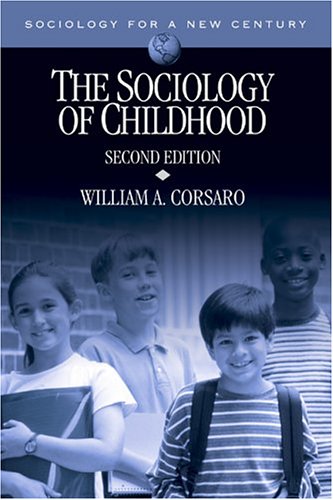The Sociology of Childhood (Sociology for a New Century Series) 2nd Edition
Corsaro, William A.
Pine Forge Press, Thousand Oaks, CA
2004
0761987517
 Since its first publication in 1997, The Sociology of Childhood has been rightly heralded as a key text of the sociological study of children and childhood. In this second edition, Corsaro updates the book to take account of what has been an unprecedentedly active period in the sociological study of children and childhood. Along with his previous summation of the scholarly literature documenting the emergence of a distinctively sociological perspective on childhood from anthropology and on children from developmental psychology, Corsaro augments this edition with more reflective thinking on the thematic issues of research methodologies and the theoretical re-conceptualisations of children and childhood which have taken place since the first printing.
Since its first publication in 1997, The Sociology of Childhood has been rightly heralded as a key text of the sociological study of children and childhood. In this second edition, Corsaro updates the book to take account of what has been an unprecedentedly active period in the sociological study of children and childhood. Along with his previous summation of the scholarly literature documenting the emergence of a distinctively sociological perspective on childhood from anthropology and on children from developmental psychology, Corsaro augments this edition with more reflective thinking on the thematic issues of research methodologies and the theoretical re-conceptualisations of children and childhood which have taken place since the first printing.
Fundamentally, the central approach remains the same, focusing on children and childhood as at the centre of analysis as subjects (in both senses of the word) in their own right, that is to say, no longer seen to be sub-categories of other disciplinary frames of reference such as family studies, education, psychology or the like. For Corsaro, this concentration on children and childhood lends itself most forcefully to the focus on children as agents existing primarily within their own peer cultures, whose own understandings, symbols and other meanings systems are sufficiently potent to significantly influence broader social phenomena such as social change, family life, and education. This reversed perspective highlights the importance of children's peer relationships in comparison to the more conventional adult-child interactions, emphasising the social problems of and for children, and the appropriate way to do research with and on children. This alterative perspective on children's peer cultures focuses on issues such as friendships, autonomy, 'cooties', cross-cultural contexts, and children's own envisaged futures for those up to pre-adolescence or 12 years of age.
This is an excellent, well-researched and highly readable book, with children's voices and Corsaro's intimate familiarity with their everyday lives and cultures shining through. The scope and depth of his knowledge of the field enable him to place sometimes controversial or as yet followed-up lines of inquiry in context, inviting further future areas of research, as for example in his excellent summation of the work of Linda Pollock (1983), whose usage of diaries and other documentary materials to recover a history of children's lives has yet to be adequately taken up by contemporary researchers in the field.
Though this book provides great insights into children's peer cultures and everyday lives, there are times when the relative exclusion of adults from the frame seems to limit the perspective on the issue at hand, as for example in the case of the seemingly unidirectional development of intimate and proto-sexual (to use Stevi Jackson's term) behaviours in non-abusive interactions among children themselves. It is as if Corsaro's acknowledgement of the moral panic which reigns in these areas of children's lives in such close proximity to the adult world (and especially in relation to the private domain of the family) makes such topics into something of a 'no go' area. Similarly, a lack of attention to the growing sociological awareness of the body does not yet seem to have filtered down to the sociological study of children's bodies, which is a considerable limitation given the overt sexualisation of children's bodies in contemporary (adult) culture. In addition, the issue of technology and other 'cross-over' phenomena originating from the adult world of capitalist economics (one thinks of things such as mobile telephones) do not seem to have the prominence in this text that they appear to have in the outwardly observable children's everyday lives. Finally, on the issue of the methodology, the coverage doesn't appear to adequately reflect the current high levels of interest, anxiety and debate on the ethics of doing research on and with children.
Notwithstanding these relatively recent topical concerns, this remains an outstanding text situating the sociology of children and childhood, which would benefit anyone who wishes to gain a solid historical, theoretical and methodological understanding of this vitally important and fast-growing research area.
Melissa Dearey
The Open University

